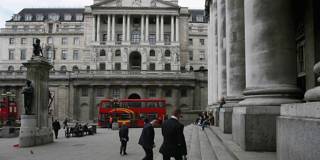Quantitative easing risks generating its own boom-and-bust cycles, and can thus be seen as an example of state-created financial instability. Governments must now abandon the fiction that central banks create money independently from government, and must themselves spend the money created at their behest.
LONDON – Amid all the talk of when and how to end or reverse quantitative easing (QE), one question is almost never discussed: Why have central banks’ massive doses of bond purchases in Europe and the United States since 2009 had so little effect on the general price level?
Between 2009 and 2019, the Bank of England injected £425 billion ($588 billion) – about 22.5% of the United Kingdom’s 2012 GDP – into the UK economy. This was aimed at pushing up inflation to the BOE’s mandated medium-term target of 2%, from a low of just 1.1% in 2009. But after ten years of QE, inflation was below its 2009 level, despite the fact that house and stock-market prices were booming, and GDP growth had not recovered to its pre-crisis trend rate.
Since the start of the COVID-19 pandemic in March 2020, the BOE has bought an additional £450 billion worth of UK government bonds, bringing the total to £875 billion, or 40% of current GDP. The effects on inflation and output of this second round of QE are yet to be felt, but asset prices have again increased markedly.

LONDON – Amid all the talk of when and how to end or reverse quantitative easing (QE), one question is almost never discussed: Why have central banks’ massive doses of bond purchases in Europe and the United States since 2009 had so little effect on the general price level?
Between 2009 and 2019, the Bank of England injected £425 billion ($588 billion) – about 22.5% of the United Kingdom’s 2012 GDP – into the UK economy. This was aimed at pushing up inflation to the BOE’s mandated medium-term target of 2%, from a low of just 1.1% in 2009. But after ten years of QE, inflation was below its 2009 level, despite the fact that house and stock-market prices were booming, and GDP growth had not recovered to its pre-crisis trend rate.
Since the start of the COVID-19 pandemic in March 2020, the BOE has bought an additional £450 billion worth of UK government bonds, bringing the total to £875 billion, or 40% of current GDP. The effects on inflation and output of this second round of QE are yet to be felt, but asset prices have again increased markedly.